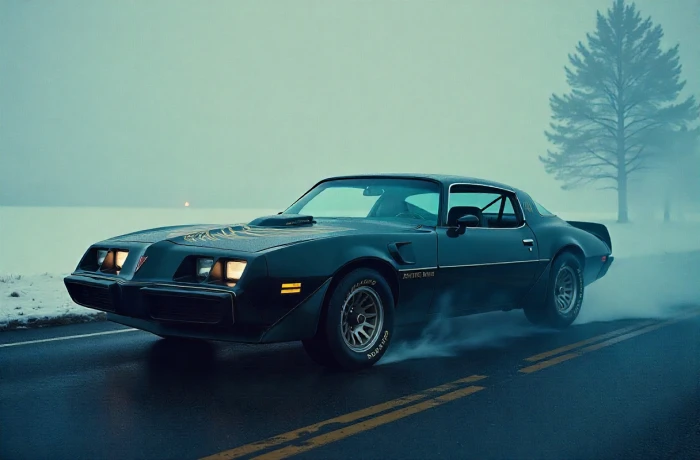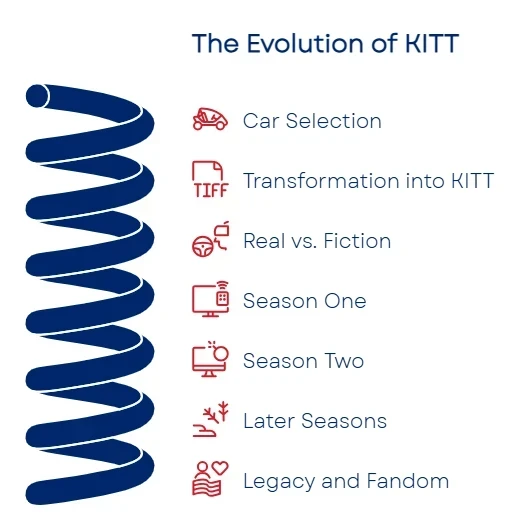The Car That Captured Our Imagination
If you’ve ever wondered what the Knight Rider car was, it was the 1982 Pontiac Trans Am that could talk, think, and even jump through the air like it owned the road. When I was a kid, I remember sitting cross-legged on the living room floor, eyes wide, watching KITT’s red scanner light sweep side to side. It felt alive.
And back then, the idea of a car that could drive itself and keep its driver safe seemed like pure science fiction.
What You’ll Learn
By the time you finish reading, you’ll know exactly:
What the Knight Rider car was, and how it came to be on television
What made KITT stand out from every other car of its time
Why the Knight Rider car remains a cultural icon today
Overview: A Closer Look at KITT and Its Origins
The Knight Rider car, better known as KITT, is one of television’s most iconic vehicles. Built on a 1982 Pontiac Trans Am, it garnered attention with its sleek black appearance, intelligent features, and crime-fighting capabilities. People couldn’t believe a car could be this advanced, and it became a symbol of what the future might hold.
Here’s a more detailed breakdown:
The car’s origins
Producers picked the 1982 Trans Am because it looked futuristic and aggressive, with lines that made it perfect for a high-tech hero car.
The transformation into KITT
Hollywood designers gave the car a complete makeover, featuring a red scanning light, glossy black paint, a custom dashboard with numerous buttons and screens, and a distinctive nose design that stood out.
Real vs. fiction
KITT's extraordinary abilities, such as speech, self-driving, and vehicle leaps, were achieved through clever tricks and special effects. Despite being fictional, the technology seemed real to audiences.
Legacy and fandom
KITT inspired thousands of replicas, model cars, and a dedicated fan community. Even now, it stands as one of the most beloved pieces of 1980s television history.
The Car That Started It All: The 1982 Pontiac Trans Am
The Knight Rider car began its life as a standard 1982 Pontiac Trans Am, straight off the lot. So why did the show’s creators pick this car? It was already something out of the future.
At the time, the Trans Am had just undergone a redesign. Its sharp lines, pop-up headlights, and aerodynamic body made it stand out. The car looked fast even when it wasn’t moving, which is precisely what the producers wanted for their high-tech crime-fighter. And since Pontiac was eager to show off their latest muscle car, it was easy to get several brand-new Trans Ams straight from the factory.
The Trans Am came with a V8 engine that could accelerate from 0 to 60 miles per hour in just over nine seconds. That might not sound fast now, but back then, it was a solid performance for a car you could buy at a dealership. Underneath all the TV magic, it was still a tough, capable muscle car that provided the show with a solid foundation to build on.
Building a Legend: How the Trans Am Became KITT
Turning an ordinary Trans Am into the Knight Rider car wasn’t easy. The team behind the show sought a sleek, intimidating, and characterful vehicle, one that felt alive even when parked.
That vision came to life thanks to Universal Studios and designer Michael Scheffe. Scheffe led the team that gave KITT its unforgettable look. The changes started on the outside: the car got a glossy black paint job, a custom-built front bumper, and, of course, that glowing red scanner light on the nose that seemed to watch everything in front of it.
The windows were tinted darker, special wheels were added, and the body was smoothed out to give it a more futuristic appearance than anything else on the road. Even little things like the mirrors were replaced with cleaner, more modern-looking parts.
On the inside, the dashboard was completely redone. They covered it with fiberglass panels featuring fake computer screens, flashing lights, and an unusual yoke-style steering wheel instead of the standard round one. The tan seats and carpeting gave it a warm but high-tech feel, as if you were sitting inside a spaceship instead of a car.
What Was Real vs. What Was TV Fiction
Behind the Magic: What Was Real and What Was TV Fiction
It’s easy to forget that the Knight Rider car was still, underneath all that style, a regular Trans Am. On TV, KITT could talk, drive itself, jump over other vehicles, and even “think.” But how much of that was real?
The answer: almost none of it. The engine and mechanics were standard. The car didn’t have an AI or a turbo boost button that made it fly. Those features were created by the writers and achieved using creative techniques.
Here’s how they pulled it off:
Self-driving scenes used stunt drivers hidden low in the seat or remote-controlled cars rigged to drive from the back.
The famous jumps were done with lightweight stunt cars built on a modified VW Beetle chassis so that they could take the abuse of landing.
All those lights and sounds on the dashboard? It's pure Hollywood magic. None of those buttons did anything.
Even though it was fiction, audiences loved the idea of a car that could protect its driver and outsmart the bad guys. And those clever illusions worked so well that KITT still feels like it was ahead of its time.
Changing Through the Seasons: KITT’s Evolution
Throughout the show, the Knight Rider car evolved to meet the audience's expectations and the demands of the story.
Here’s how KITT changed from season one to season four:
Season One: The Original Look
Slim red scanner light with a subtle glow.
Simple, clean dashboard with tan seats and basic monitors.
Sleek, understated nose and bumper design.
Season Two: Brighter and Busier
The scanner light is made brighter with a faster sweep effect.
The dashboard was updated with more flashing lights, extra buttons, and added screens.
There are slightly darker interior tones to give a more serious feel.
Later Seasons: Sharper and Flashier
The front bumper and nose were redesigned to look more angular and aggressive.
New decals and minor body tweaks for stunt cars.
Advanced stunt cars and props were added to handle more brutal scenes and tricks.
A Vision That Still Inspires
More than just a television icon, the Knight Rider car offered a visionary look into the future of automobiles.
It imagined a future of cars that could communicate and protect their drivers— a concept that continues to ignite the imaginations of car enthusiasts, engineers, and visionaries alike. Decades later, KITT's legacy remains undisputed: it was more than merely a vehicle; it was a powerful foreshadowing of automotive advancements to come.
Need Help Shipping Your Car?
If you're a proud owner of a KITT replica, a classic Trans Am, or any other special vehicle, getting it from point A to point B safely can be a significant concern. Whether you're moving, attending a car show, or buying a new addition to your collection, carefully arranged shipping makes all the difference.
AmeriFreight Auto Transport specializes in coordinating transport with vetted carriers nationwide who understand the unique needs of car enthusiasts and aim to deliver your vehicle to its destination with the utmost care.
Frequently Asked Questions (FAQs)
What year was the Knight Rider car?
The Knight Rider car was a 1982 Pontiac Firebird Trans Am, selected for its futuristic styling and performance capabilities.
Did the car drive itself?
No. On the show, hidden stunt drivers and remote-control rigs were used to create the illusion of self-driving.
Can you buy a replica of KITT today?
Yes, fans and specialty builders offer detailed replicas, and collectible models are also widely available.
How many actual KITT cars were built for the Knight Rider TV show, and what happened to them?
Around 15 to 20 Pontiac Trans Ams were modified to play KITT during the show’s production. Most were destroyed during filming or scrapped afterward. A few screen-used cars survive today in private collections and museums.
Did David Hasselhoff own any of the original KITT cars, and what happened to them now?
David Hasselhoff did not keep any of the original KITT cars used on the show. However, he has owned replica KITTs over the years, some of which have been displayed or sold at charity auctions.
Disclaimer: This article is for informational and entertainment purposes only. The Knight Rider Car is a fictional vehicle from a television series, and while some replicas exist, they are not affiliated with the original creators or licensed properties. Any references to custom builds or fan-made projects are based on publicly available information and are not endorsements. Always consult a qualified professional before attempting any automotive modifications or large-scale vehicle builds.















